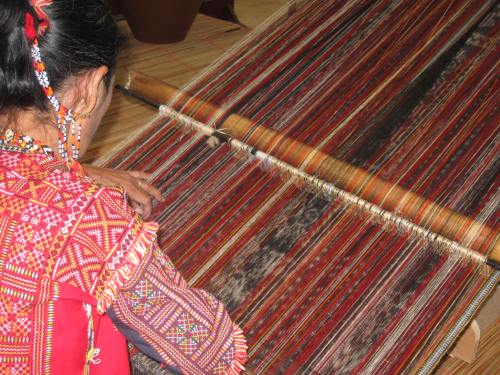
Inset is Ambit Onse (+), Bagobo giangan, who plays the kulintang
The kulintang is a form of musical instrument that is used by the Bagobos, Mandayas, Tagakaolos and Matigsalugs of Davao. Being made up of casted bronze or brass traded to Davao tribal peoples by bartering Muslim tribes from Singapore or Malaysia, it is shaped like a small-rounded sphere with knobs. Whenever an occasion demands that music be heard for such as those of a wedding, harvests or simply in honor of a Datu, a kulintang will be displayed for all to hear and see.
The Bagobo kulintang, differing from its Tausug, Maranaw or Maguindanao counterparts is normally hanged upright . They are neatly and orderly stacked. Using small padded sticks called “tap-tap”, a player will usually play the tune while another player, thumps on the bass gong as accompaniment. The melody usually starts with a solemn, slow and rythmic pounding of the gong and thereby progresses into a much faster, pulsating and cheerful tone. It is at this point that the people begin to be excited and are being invited to dance.
Dances among Davao’s tribes such as the Bagobos involve the rythmic shuffling of the feet, with the woman anticipating the dance movements of man. Both men and women adorned with the traditional Bagobo abaca-textured attire, regaled with colors, beads and brass bells, will be seen swaying beautifully in a ritualistic manner.
There are certainly types of kulintang melodies by which Bagobos express their feelings. For a festive mood, they have the “inday-inday, sowroy or the tagunggo“. At the time of death, the Bagobos also play a certain melody to announce a sad tiding. The playing of the kulintang is unlike the western musical contrivances that involves formal note compositions. The Malayan gong usually employs a “pentatonic-type” of musicality. This is defined in the dictionary as a musical scale with 5 noted per octave in contrast to a heptatonic type or 7-note scale. Because the music is orally transmitted, it has room for further musical elucidation, depending upon the feelings of the player.
The kulintang ever becomes a regal instrument if only it renders a beautiful melody as great as the skill and as lofty as the feelings of the player.
For the Bagobos, the sound of the kulintang does not only rekindle ancient memories and blood ties, but also reminds them of their dignified place in Davao’s history.













